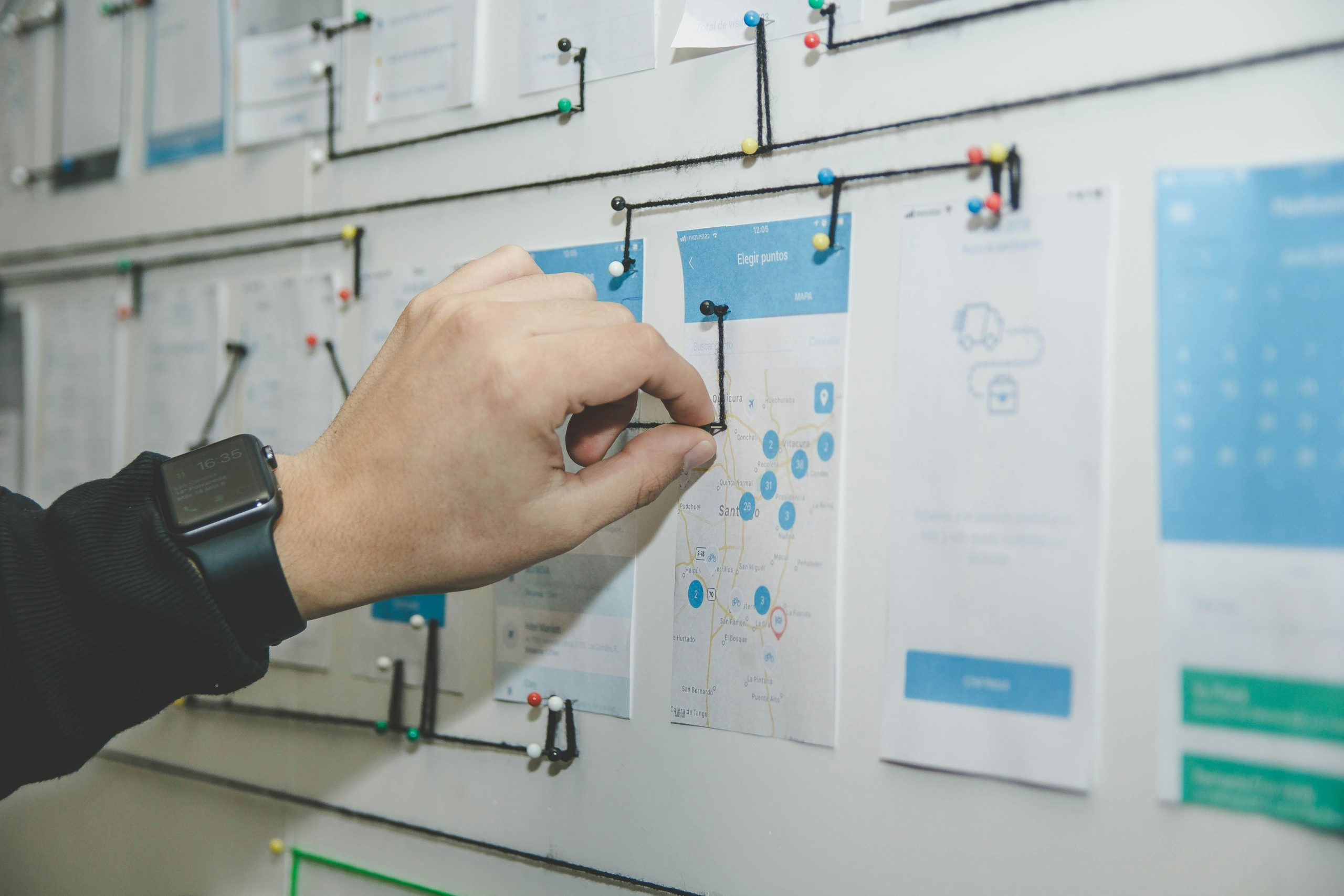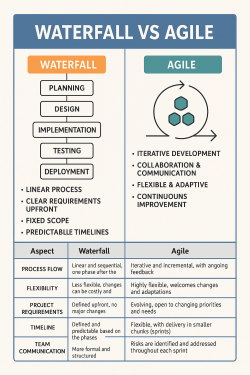Waterfall vs Agile: The Essential Guide to the “Big Two” Methodologies in 2025
June 11, 2025

Waterfall vs Agile: two of the most widely known project management methodologies, each offering distinct advantages and challenges. While both have been successfully applied across a range of industries, the best choice for your project depends on its specific requirements, complexity, and objectives.
At The Bridge Digital, we work with clients to determine which approach will be most effective for their projects. In this post, we’ll break down the key differences between Waterfall and Agile, and provide guidance on when to use each methodology. Understanding Waterfall vs Agile at a deeper level allows businesses to align project execution with long-term goals.
1. What is Waterfall?
Waterfall is a traditional project management methodology that follows a linear, step-by-step approach. It’s called “Waterfall” because each phase of the project flows downward, like a waterfall, into the next. This means that each stage is completed before the next one begins, and changes are often difficult to make once a phase is complete. When comparing Waterfall vs Agile, Waterfall is the go-to model for predictability and structure.
Key Characteristics of Waterfall:
- Linear Process: The project moves in a clear, sequential path from one phase to the next (e.g., Planning, Design, Development, Testing, Deployment, Maintenance).
- Clear Requirements Upfront: Waterfall projects typically require detailed specifications and requirements at the start of the project, and the team works toward these predefined goals throughout the project’s lifecycle.
- Fixed Scope: Once the scope and plan are agreed upon, they usually remain unchanged. Any changes require significant rework and may affect timelines and costs.
- Predictable Timelines: Due to the linear process, it’s often easier to estimate timelines and deliverables, especially for well-defined projects.
2. What is Agile?
Agile, on the other hand, is an iterative and flexible approach that focuses on delivering small, incremental updates to a project rather than one final deliverable at the end. Agile allows teams to adapt to changes and new requirements throughout the project lifecycle, which makes it especially useful for projects where requirements evolve over time. When comparing Waterfall vs Agile, Agile stands out for its responsiveness and adaptability.
Key Characteristics of Agile:
- Iterative Development: The project is broken into small, manageable parts called “sprints.” Each sprint delivers a working product increment, allowing teams to adjust as the project progresses.
- Collaboration & Communication: Agile emphasizes constant communication and collaboration between developers, stakeholders, and end users. Teams are encouraged to adapt quickly based on feedback.
- Flexible & Adaptive: Agile is highly flexible, allowing for frequent changes to the scope, priorities, and even the project direction as new information emerges.
- Continuous Improvement: The iterative nature of Agile means that each sprint is followed by a review and retrospective, leading to continuous improvements in both the product and the team’s processes.
3. Waterfall vs Agile: Key Differences
When choosing between Waterfall vs Agile, it’s critical to understand how each methodology affects deliverables, stakeholder involvement, and responsiveness to change. This comparison highlights their strategic distinctions:
| Aspect | Waterfall | Agile |
|---|---|---|
| Process Flow | Linear and sequential, one phase after the other | Iterative and incremental, with ongoing feedback |
| Flexibility | Less flexible, changes can be costly and difficult | Highly flexible, welcomes changes and adaptations |
| Project Requirements | Defined upfront, no major changes allowed | Evolving, open to changing priorities and needs |
| Timeline | Defined and predictable based on the phases | Flexible, with delivery in smaller chunks (sprints) |
| Team Communication | More formal and structured | Frequent and informal, with regular meetings |
| Risk Management | Risk is addressed at the end, can be high if problems arise later | Risks are identified and addressed throughout each sprint |
4. When to Use Waterfall
Waterfall is best suited for projects where the requirements are clear from the outset, and changes are unlikely to occur during the project. This methodology works well when the project scope, timelines, and deliverables are well-defined and are not expected to change significantly.
Ideal Scenarios for Waterfall:
- Well-defined projects: Projects where requirements and goals are unlikely to change throughout the course of the project.
- Regulatory Compliance: In industries where the project must adhere to strict regulatory requirements, Waterfall’s rigid structure can be beneficial for ensuring compliance.
- Construction or Manufacturing: Waterfall is often a good fit for projects with clear stages like construction, manufacturing, or hardware development, where each phase needs to be completed before moving to the next.
- Low-Risk Projects: When the project is straightforward and low-risk, and the team can confidently deliver based on the initial requirements.
5. When to Use Agile
Agile is ideal for projects that require flexibility, frequent updates, and close collaboration with stakeholders. It is particularly useful in industries like software development, where requirements often evolve or change rapidly.
Ideal Scenarios for Agile:
- Software Development: In an ever-changing tech landscape, software projects often evolve, requiring adjustments to functionality, design, and user experience.
- Uncertain or Evolving Requirements: When the full scope or details of the project are not clear from the start and are expected to change.
- Fast-Paced Projects: If your project needs to be delivered quickly and iteratively, Agile allows for rapid delivery of functional products at the end of each sprint.
- Close Collaboration with Stakeholders: When constant communication with stakeholders is critical to ensure the final product meets their needs.
- Innovation-Driven Projects: For projects that involve a high degree of innovation and exploration, Agile allows for experimentation and frequent adjustments based on feedback.
6. Choosing Between Waterfall and Agile: What’s Best for Your Project?
Choosing between Waterfall and Agile is not always straightforward. At The Bridge Digital, we work with clients to understand the specifics of their projects and select the methodology that best fits their needs.
When faced with the Waterfall vs Agile decision, ask yourself:
- Use Waterfall if you have clear, fixed requirements, a defined scope, and need predictable timelines. This is ideal for projects where changes are minimal or non-existent.
- Use Agile if your project involves frequent changes, unclear or evolving requirements, or you need to be able to adapt quickly to feedback. Agile is great for complex, high-tech projects with ongoing innovation.

7. Conclusion: Waterfall vs Agile – Which One is Right for You?
Both Waterfall and Agile have their place in the world of project management, and neither is superior in all situations. The choice between them depends on the nature of your project, the level of flexibility required, and the timeline.
By thoroughly evaluating your project’s characteristics, you can make an informed Waterfall vs Agile decision that ensures success and sustainability.
At The Bridge Digital, we believe in tailoring the project management approach to meet the needs of our clients. Whether you need the structure and predictability of Waterfall or the flexibility and iterative approach of Agile, we can help guide your project to success.
If you’re unsure which methodology is right for your project, contact us today, and we can help you determine the best path forward.
